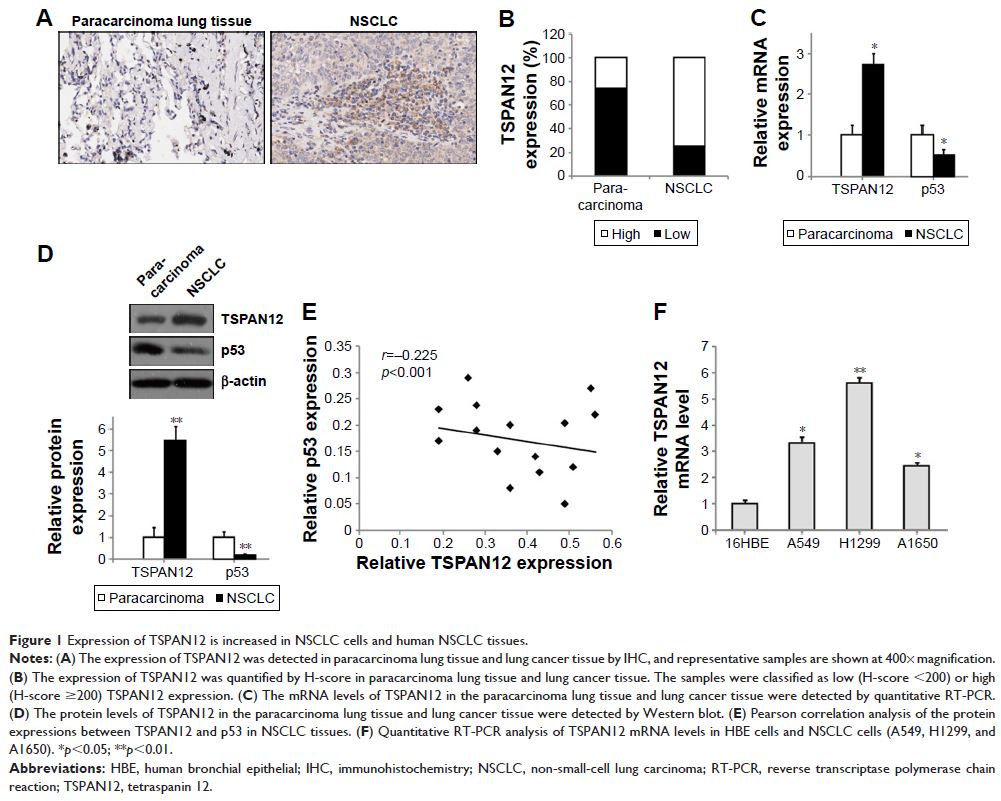108985
论文已发表
注册即可获取德孚的最新动态
IF 收录期刊
- 3.4 Breast Cancer (Dove Med Press)
- 3.2 Clin Epidemiol
- 2.6 Cancer Manag Res
- 2.9 Infect Drug Resist
- 3.7 Clin Interv Aging
- 5.1 Drug Des Dev Ther
- 3.1 Int J Chronic Obstr
- 6.6 Int J Nanomed
- 2.6 Int J Women's Health
- 2.9 Neuropsych Dis Treat
- 2.8 OncoTargets Ther
- 2.0 Patient Prefer Adher
- 2.2 Ther Clin Risk Manag
- 2.5 J Pain Res
- 3.0 Diabet Metab Synd Ob
- 3.2 Psychol Res Behav Ma
- 3.4 Nat Sci Sleep
- 1.8 Pharmgenomics Pers Med
- 2.0 Risk Manag Healthc Policy
- 4.1 J Inflamm Res
- 2.0 Int J Gen Med
- 3.4 J Hepatocell Carcinoma
- 3.0 J Asthma Allergy
- 2.2 Clin Cosmet Investig Dermatol
- 2.4 J Multidiscip Healthc

TSPAN12 通过抑制 p53 在 NSCLC 中的过表达,及促进体外和体内 NSCLC 细胞生长
Authors Hu Z, Hou D, Wang X, You Z, Cao X
Received 31 October 2017
Accepted for publication 16 January 2018
Published 1 March 2018 Volume 2018:11 Pages 1095—1103
DOI https://doi.org/10.2147/OTT.S155620
Checked for plagiarism Yes
Review by Single-blind
Peer reviewers approved by Dr Amy Norman
Peer reviewer comments 2
Editor who approved publication: Dr Ingrid Espinoza
Background: Tetraspanin
12 (TSPAN12), a member of the phylogenetically ancient tetraspanin family, is
linked to impaired vascularization of the eye called familial exudative
vitreoretinopathy, while the functional role of TSPAN12 in lung cancer has not
been well characterized.
Results: In our study, TSPAN12 is able to regulate the growth of
non-small-cell lung carcinoma (NSCLC) cells both in vitro and in vivo. TSPAN12
mRNA level was significantly increased in human NSCLC samples compared with
their corresponding paracancerous histologic normal tissues. In addition,
TSPAN12 expression, which is frequently upregulated in NSCLC, is inversely
correlated with p53 expression. Furthermore, the expression levels of TSPAN12
were also increased in three human NSCLC cell lines compared to human bronchial
epithelial (16HBE) cells. Then, we studied the effects of TSPAN12 silencing by
short hairpin ribonucleic acid on NSCLC cell growth in vitro and tumorigenesis
in vivo, along with the effect on the p53 pathway. Knockdown of TSPAN12 in
NSCLC cells inhibited cell proliferation and colony formation. In addition,
knockdown of TSPAN12 increased apoptosis in NSCLC cells. Mechanistically,
TSPAN12 could modulate the expression of p53, p21, and p27 in NSCLC cells. In a
tumor xenograft model, TSPAN12 silencing inhibits the tumor growth of H1299
cells.
Conclusion: Taken together, our results reveal that TSPAN12 plays an important
role in NSCLC and is a potential biomarker and a promising target in the
treatment of NSCLC.
Keywords: NSCLC, TSPAN12, p53, survival, cell proliferation, apoptosis
